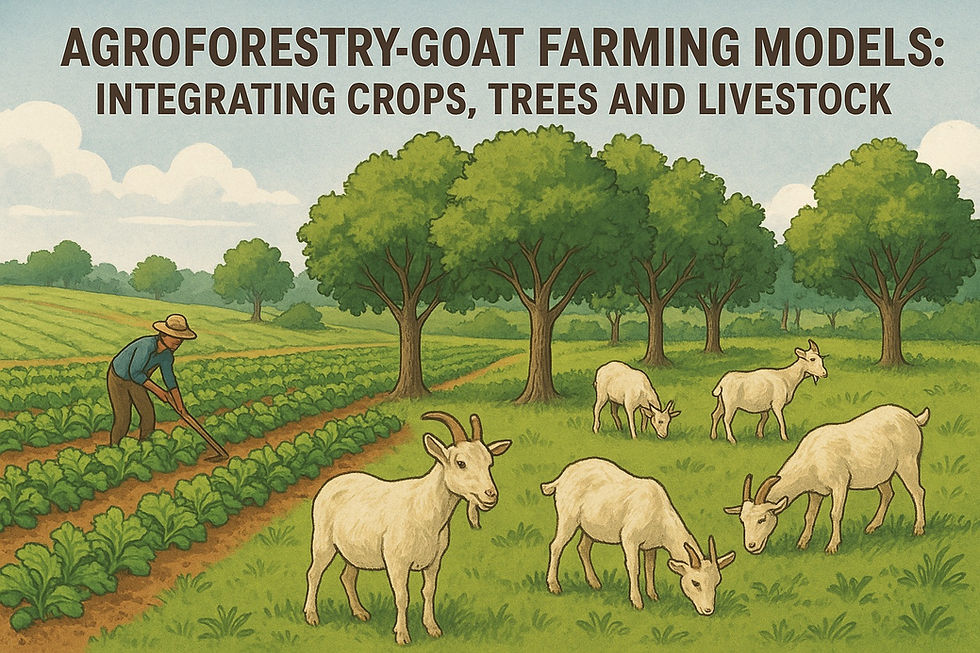From Novice to Niche: How First-Time Goat Farmers Can Build for Scale
- TGT GLOBAL Development services
- Jul 29
- 2 min read
Updated: Sep 2
Goat farming in India is no longer just a subsistence activity; it is rapidly becoming a profitable micro-enterprise for rural households. For first-time goat farmers, the path from owning a few animals to running a scalable business is full of learning curves and opportunities. This article explores how new entrants into goat farming can lay the right foundation and build towards sustainable, scalable operations.
Start with a Clear Vision: The journey to scale begins with clarity of purpose. Whether the goal is meat production, milk supply, breeding or manure sales, having a defined niche helps farmers align resources, skills and market strategies accordingly. Farmers should ask themselves:
What is my end market?
Am I catering to local consumption or institutional buyers?
Do I want to specialize in a breed like Black Bengal, Sirohi or Osmanabadi?
Invest in Basic Training and Handholding: Many first-time farmers underestimate the value of structured training. Collaborating with experienced mentors, government livestock
departments or local NGOs for basic goat husbandry knowledge is essential. Topics must include:
Nutrition and feeding schedules
Disease prevention and deworming
Reproduction cycles and kid management
Shelter design and hygiene
Pashu Sakhis—trained community animal health workers—play a vital role in supporting novice farmers with on-ground, contextual guidance.
Start Small, But Strategically: Scaling does not mean starting big. Beginning with 5–10 goats allows farmers to manage risks and build learning without heavy investment. However, selection of breed, age and health status at the start should be strategic:
Buy from reliable sources
Avoid sick or low-weight animals
Focus on female-dominated herds for multiplication potential
Record-Keeping from Day One: Scalability hinges on discipline. Even at a small scale, maintaining basic records—births, deaths, sales, vaccinations and expenses—enables data-driven decisions later. These records also help when approaching banks, cooperatives or Farmer Producer Organizations (FPOs) for support.
Connect with the Collective: Isolation limits scale. Joining goat rearer groups, cooperatives or FPOs gives farmers:
Better bargaining power for input purchases and product sales
Access to veterinary services, insurance and credit
Platforms to share best practices and pool resources
Group-led scaling is often more resilient and equitable.
Prepare for Market Linkages Early: First-time farmers should not wait until they have a large herd to think about the market. Early market exploration helps determine:
Demand cycles and price trends
Buyer preferences (live weight, breed, festival timing)
The viability of selling through local hat's vs. organized buyers
Linking with processors, meat shops, or online livestock platforms adds greater value and reach.
Reinvent and Reinforce: Scaling is not linear. As herds grow, new challenges emerge—disease outbreaks, feed shortages, or thefts. Building resilience through:
Fodder banks or hydroponic feed
Vaccination calendars
Insurance or mutual support schemes help farmers move from reactive to proactive business management.
The potential for smallholder goat farmers in India is immense. With strategic beginnings, consistent learning and the right networks, even a first-time farmer can transition from subsistence to surplus and from surplus to enterprise. Scaling a goat farming business is less about size and more about systems. Start smart, stay steady—and the scale will follow.



Comments